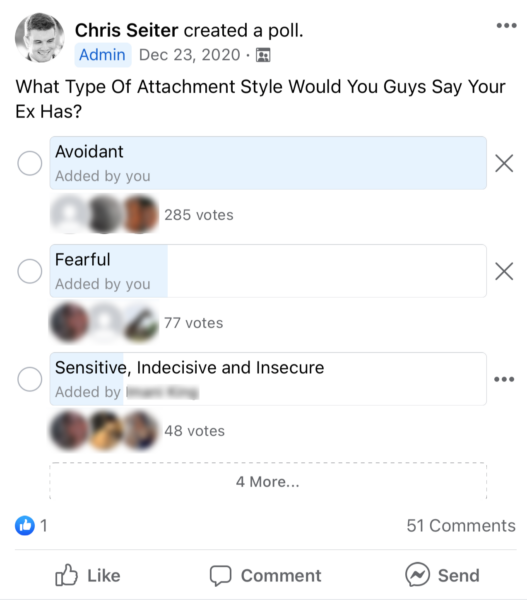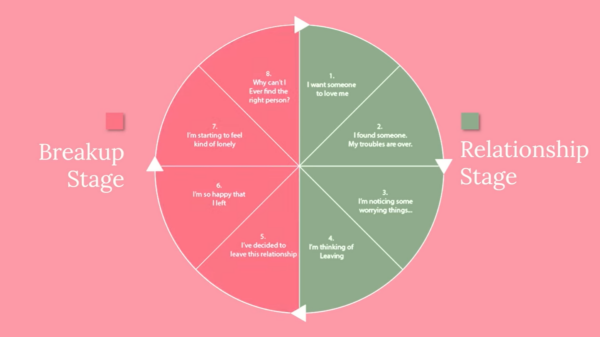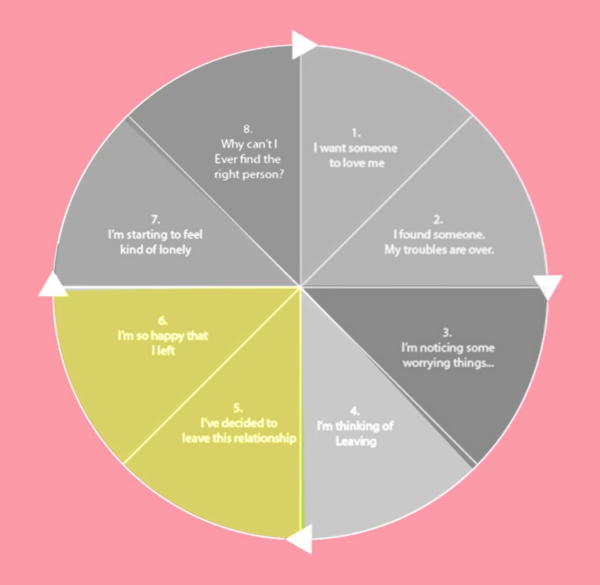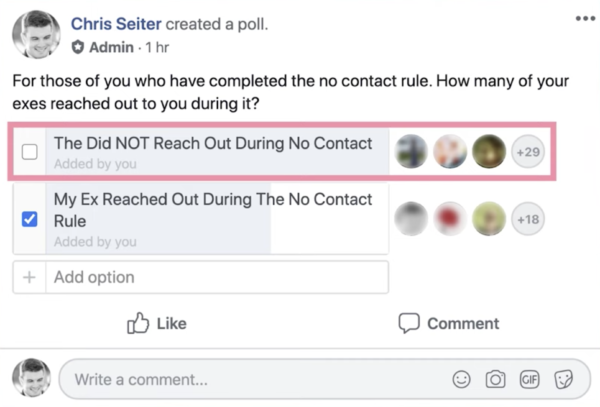Today I’m going to show you exactly how a dumper feels after a month of no contact.
Now, in the past I’ve talked a little about this concept both here and here but with this article I wanted to really focus in on that one month mark.
Generally you’ll find that the most popular version of the no contact rule is the 30 day rule.
So, what exactly is the dumper thinking? What are they feeling?
Well, this study starts first with understanding the journey that a dumper will typically go through from before, during and after a breakup.

What Are Your Chances of Getting Your Ex Boyfriend Back?
Take the quizThe Dumper Death Wheel Trap
Ok, before I begin the crux of my argument I want to go on record and say that my team and I have studied the behavior of more dumpers than of the other breakup related websites you’re going to come across.
What makes us different than those websites is probably how public we are with our findings.
For example, we know from polling our private Facebook support group members a few years ago that most dumpers tend to be classified as “avoidants.”
And for me that’s the single most important piece of information to have when trying to answer a question like “how is an ex feeling a month after a breakup.”
What makes avoidants unique is the simple fact that most are caught in a relationship death cycle without even being aware of it.
This death cycle,
If you are a frequent visitor of this website or have watched my YouTube videos this won’t be new to you. I’ve talked about it so much that you’re probably sick of it.
But if you are new to the website or it’s the first time seeing this bad boy here’s the breakdown. Basically this shows you what the experience of a dumper (who has an avoidant attachment style) is like from the beginning of a relationship all the way to the end and then past that even.
You can see that I’ve divided our pie graphic above into two sections,
- The relationship stage (green)
- The breakup stage (pink)
There are eight main stages to this wheel.
- The dumper wants someone to love them (green)
- They find you and believe their troubles are over (green)
- They notice some worrying things (green)
- This causes them to think of leaving (green)
- They actually leave (pink)
- They are happy they left (pink)
- They start to feel lonely (pink)
- They wonder why this always happens to them (pink)
Now, generally no contact happens right around this stage,
And really that’s where the big misconceptions begin with most people who hear about the no contact rule begin.
The Misconception People Have About The No Contact Rule
So, if you make the rounds online and simply type “no contact rule” into Google you are going to get a slew of articles written that highlights the positive aspects of no contact.

What Are Your Chances of Getting Your Ex Boyfriend Back?
Take the quiz- It’ll make your ex reach out to you.
- It’ll help you get over the breakup
- It’s reverse psychology at its finest
Surface level stuff.
And that’s because the no contact rule has become a business in and of itself. Large conglomerate owned websites employ writers who know what will get people to click.
It’s always easier to tell an outlier story revolving around a no contact rule that makes it this new sexy thing than it is to display the truth.
So, what is the truth?
Well, according to my research most exes WON’T reach out to you during the no contact rule.
And if you understand the context of why it makes total sense.
This happens because most of the time when you are using a no contact rule on your ex it is during phase #6 on the wheel pictured above, the “I’m so happy I left” phase.
Now, that’s not to say the no contact rule is ineffective. I didn’t say that. It’s still THE smartest thing you can do for yourself after a breakup but to assume that it’s going to be the only thing that’s going to make an ex magically come back is just false.
But I’m getting off topic.
How The Dumper Feels After A Month Of No Contact
The ultimate aim of this article is to help you understand how a dumper is feeling after a month of no contact. Well, after a month of no contact usually a dumper is going to be feeling one of two ways.
- They’ll still be smack dab in the middle of “separation elation” during phase six in the wheel
- They’ll be transitioning to an inevitable depressive episode which they will try to repress
As always, I’d like to go deeper so let’s tackle each of these outcomes.
Separation Elation
Once again I’d like to point to this transitionary phase in the wheel.
This is when no contact rule is going on.
It also happens to be where your ex is going through “separation elation.”
You know, that period in time where your ex brags about,
- Winning the breakup
- How great they are doing without you
- How they may go on the rebound
- Etc
The question that we really need to ask though is how long this separation elation can last.
And that’s a much harder thing to determine because really what we are asking is how long that transition point between phase six and phase seven is.
For your refreshment,
- Phase six = I’m so happy I left
- Phase seven = I’m feeling lonely/depressed
The transition between those two points varies widely.
I’ve seen dumpers where stage six can last as little as a week and dumpers where it can last as long as four months.

What Are Your Chances of Getting Your Ex Boyfriend Back?
Take the quizThat’s a huge discrepancy. Though if you are going to hold me to an answer I think it would be accurate to say that separation elation is a little like a mini honeymoon period.
It isn’t as potent though and therefore it doesn’t last as long. Expect it to last on average about 1.5 months.
This might be why we’ve actually started seeing better results (from a responsiveness case) for our clients doing 45 days no contact as opposed to the traditional thirty.
But I suppose to answer the inevitable question of which this article is about,
The way a dumper feels after a month of no contact is that they’ll usually still be stuck in the “separation elation” phase.
Don’t fear though, the bell will toll as the depressive episode is just around the corner.
Understanding The Depressive Episode
I made the death wheel trap with the assumption that it could be applied directly the avoidants.
Last year I talked about avoidants a lot.
And what I always found interesting about them was that their need for independence often came at the cost of personal happiness.
They’d rather avoid grief or repress it than process it and learn like a secure attachment individual would.
One of the big arguments I have for bumping the traditional 30 day no contact rule up to a 45 day one is the simple fact that the exact time that you want to be re-contacting your ex is when they are out of the separation elation stage.
You want to be the solution to their grief.
And what’s funny is that often what I’ve seen happen is that when a dumper is in the midst of the separation elation phase they get pangs of grief that seeps through the cracks and this grief terrifies them so they respond the only way they know how, repression.
They’ll date others thinking that this will solve their problem.
It doesn’t.
In fact, in some ways it can make things worse as they feel more disconnected while dating them. This all leads up to the depressive phase that you see towards the end of my death cycle wheel.
The “why is this always happening to me?”
The “woe is me” attitude.
But since avoidants are so fiercely independent they don’t lack personal confidence. Instead, for them it’s easier to blame outside sources or to have their feelings linger on a phantom ex.
The one that got away.
That’s actually what causes them to “come back” after years. They romanticize this special person that got away but they are forever trapped in that death wheel and that person never lives up to their ridiculous expectations.

What Are Your Chances of Getting Your Ex Boyfriend Back?
Take the quizOne of my challenges for 2023 is to dig deeper and understand how you can break them out of this wheel. It’s possible. I’ve seen it happen but I don’t understand all the nuances just yet.
Though, if I were to hazard a guess my guess is that it would have something to do with helping their own attachment become more secure.
But I’ll leave it up to you. What do you think would work to break the avoidant out of the cycle? Leave a comment below.




Caro
February 4, 2023 at 10:01 pm
I’m in exacting this situating with my ex. You’ve clarified and distilled the situation so clearly.
I’ve heard that if the anxious attachment person works to arrive at a place of secure attachment, then that can sooth the avoidant and pull them into a more secure attachment phase.
This is the hope.
X
Lynn
January 30, 2023 at 8:02 pm
I think you’re right that the solution to getting them out of the wheel is helping them become more secure. If we end up back together, I’d love to learn more about how a partner can support someone becoming more secure, while maintaining my own “typically anxious, but working on being secure” independence myself. Don’t want to become codependent- their work is their work. I don’t want hot and cold again, but I do believe that real partnership involves being able to support the growth of each other.